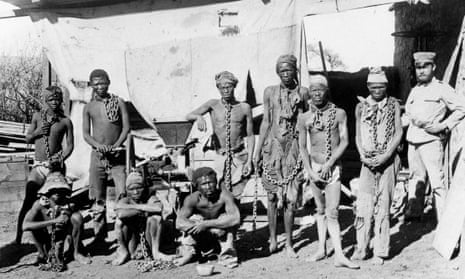One morning last summer, I was ushered into a little office in the Botswana National Archives. I’d asked the archivists to dig out a document that I had wanted to see for 20 years. After a couple of phone calls, the file was brought in. Near the top of a stack of yellowing papers was a signed, original copy of the Vernichtungsbefehl – the extermination order.
Drafted in 1904, it is an explicit command for the extermination of an entire people. It bore the signature of its author, the German general Lothar von Trotha, and was addressed to the Herero people of Namibia, Botswana’s neighbour to the west, and formerly the German colony of South West Africa. The final sentences translate as: “The Herero nation must now leave the country. If it refuses, I shall compel it to do so with the ‘long tube’ (cannon). Any Herero found inside the German frontier, with or without a gun or cattle, will be executed. I shall spare neither women nor children. I shall give the order to drive them away and fire on them.”
Within three years, four-fifths of the Herero and half the Nama, another of Namibia’s ethnic groups, were dead.
When I began to work on this subject 14 years ago, I, like other historians, met with a wall of resistance and denial. (I eventually wrote, with Casper W Erichsen, The Kaiser’s Holocaust.) While there was always something frantic and faintly desperate about the repudiation of such a well-documented history, what motivated it was obvious. Germany was troubled not by the language of the extermination order but by the fact the liquidation was completed in what the German authorities openly termed Konzentrationslager – concentration camps.
What took place in Namibia between 1904 and 1908 horribly prefigured the crimes of the century that followed. The Germany army, with the complicity of colonial administrators – bureaucratic, desk-bound killers – exterminated thousands of men, women and children in concentration camps. They transported their victims to those camps in cattle trucks and used labour and hunger to kill. So brazen were they that the ledgers in which the deaths of the prisoners were recorded came with the column “cause of death” pre-printed with the phrase “death through exhaustion, bronchitis, heart disease or scurvy”. All this 30 years before the Nazis even came to power.
The facts are so shocking, the parallels so obvious and the wall of denial so high that, back then, I found it impossible to envisage that Germany would ever come to terms with what her forces had done in Africa a century ago.
There are signs that Germany is preparing to grasp this most difficult of historical nettles. In 2011, German museums began to repatriate the skulls of victims of the concentration camps, human remains that had been experimented upon by race scientists. Last July, the foreign minister, Frank-Walter Steinmeier, described what had happened in Namibia as “a war crime and a genocide”. A Berlin museum is currently holding an exhibition on Germany’s colonial era and the German government is said to be in advanced talks with that of Namibia. The hope is that Germany will issue an official apology. There is even talk of some sort of compensation – reparations, even.
In ordinary times, this would be commendable. Within the context of 2017 it is almost incredible. With Donald Trump days away from inauguration, populist, anti-immigrant parties on the march across Europe and the far-right of neighbouring Austria winning 46% of the vote in recent presidential elections, Germany is inching towards accepting the most appalling of her colonial crimes and thereby confirming her status as the great bastion of inclusive, multicultural liberalism in Europe.
But how is it that the European nation with the most toxic history is apparently willing to open up yet another chapter in that troubled past? Is it, in fact, because so much of German history is so very toxic that the modern state is capable of looking upon her past as repository of cautionary tales, rather than a source of national glory?
Yet while Germany confronts the fact that in a forgotten colony her soldiers and bureaucrats carried out a genocide in the name of a kaiser rather than a führer, we in Britain remain unable even to acknowledge crimes of a figure such as Cecil Rhodes, a man who was widely regarded as a monster even at the time.





